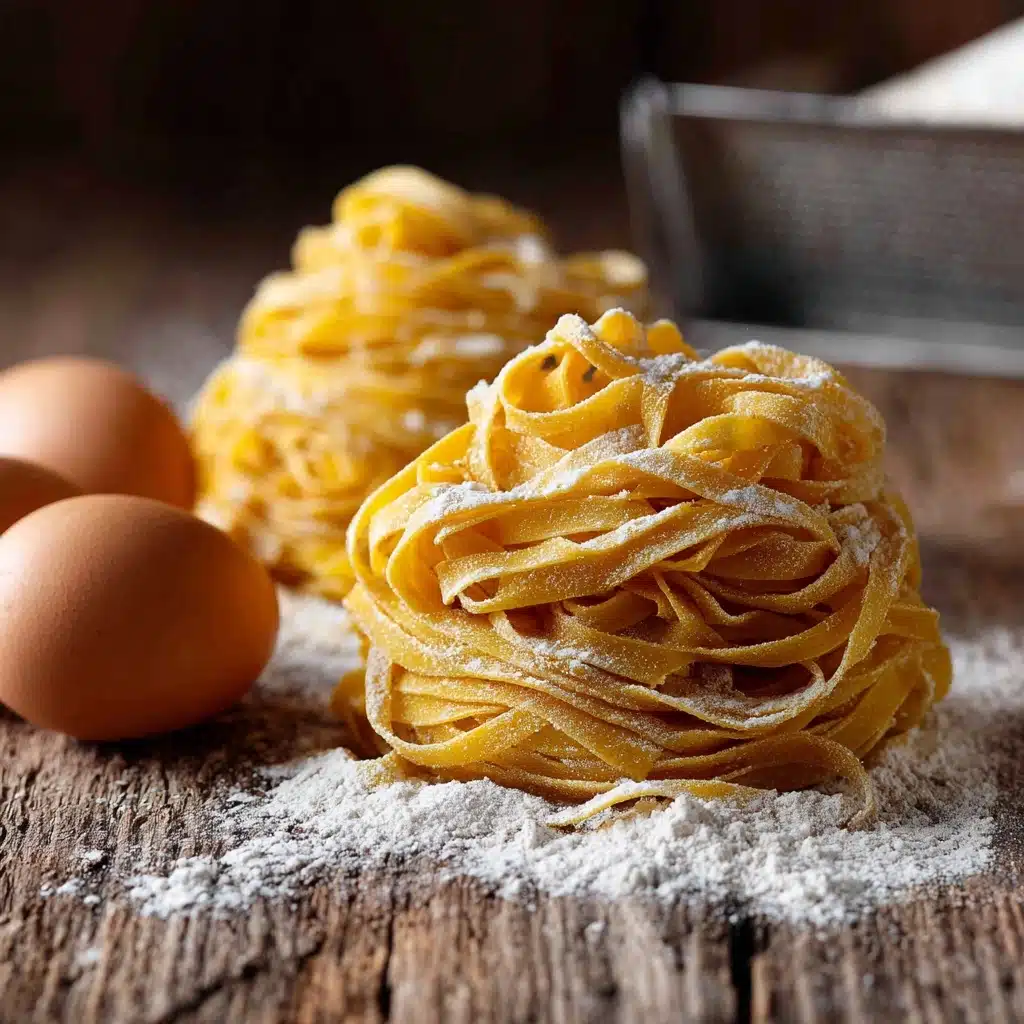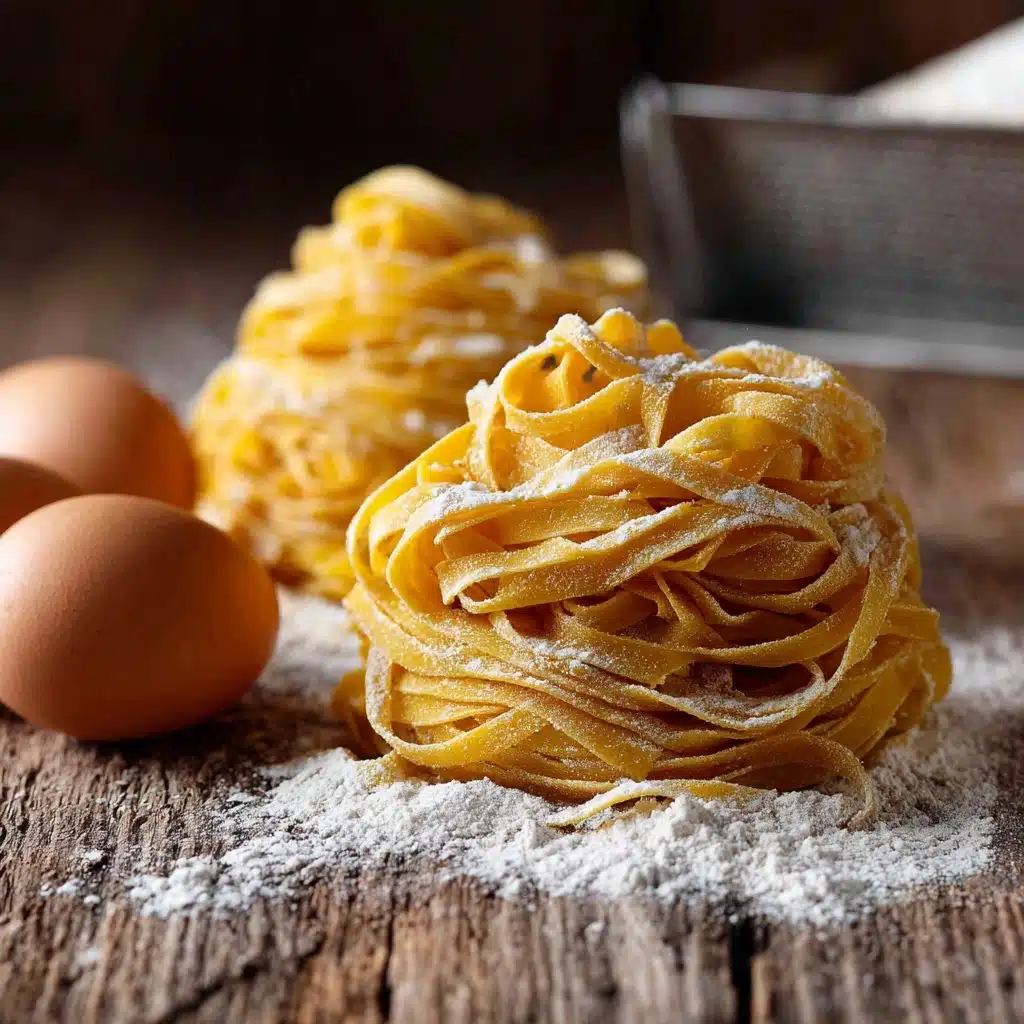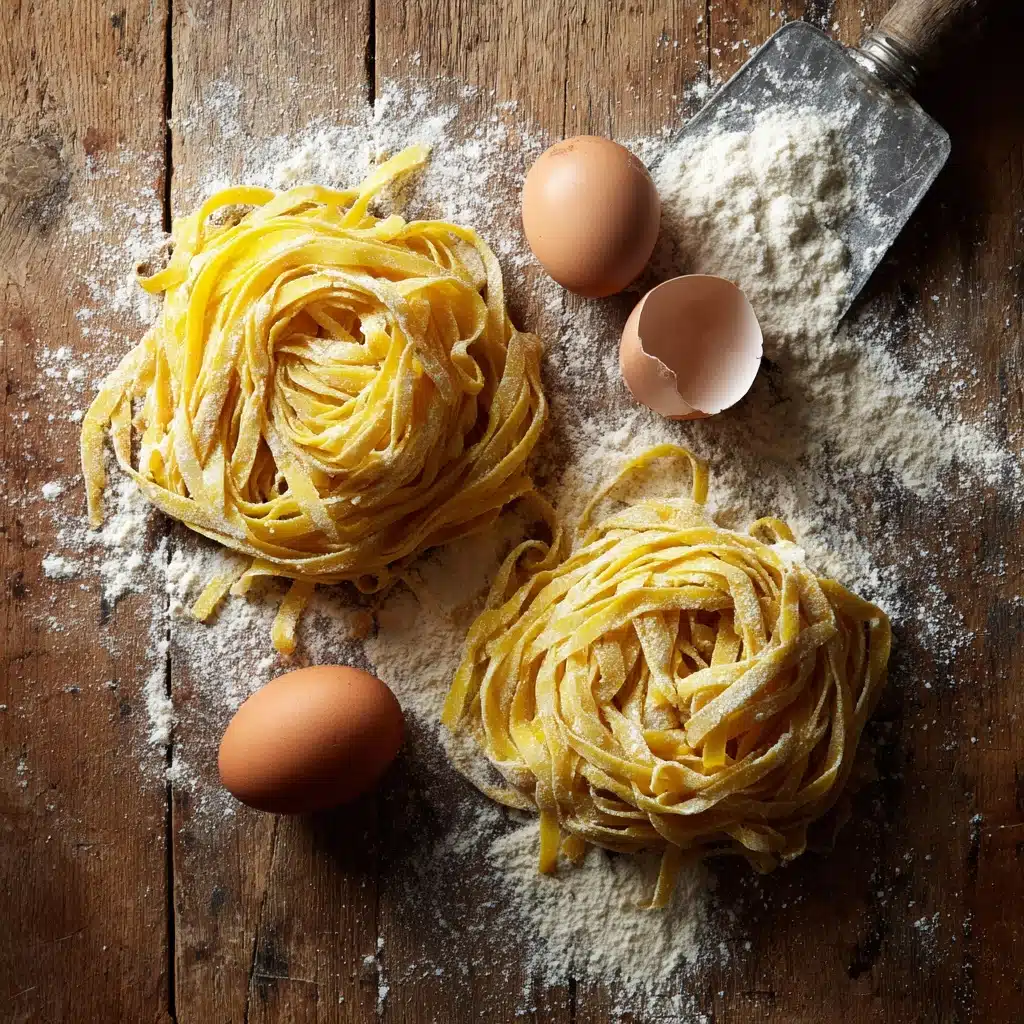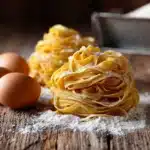Once you’ve tried Homemade Pasta, you’ll never look at a store-bought box the same way again! This recipe captures the magic of transforming just a few humble ingredients—flour, eggs, salt, and a splash of olive oil—into silky, luscious noodles that elevate any meal. Whether you’re rolling the dough with a well-loved pin or cranking it through a pasta machine, the process feels as satisfying as the final plate. Trust me, your kitchen will smell divine, and the flavors truly shine in every tender bite.
Ingredients You’ll Need
Believe it or not, the best Homemade Pasta comes down to just a handful of pantry staples! Each ingredient plays a specific role: flour for structure, eggs for richness, salt for seasoning, and a little olive oil for added silkiness. Let’s take a closer look at what you’ll need to create pasta perfection.
- All-purpose flour: Provides the backbone for your dough, yielding a soft yet sturdy texture that’s endlessly versatile.
- Large eggs: Bring richness, color, and help bind the dough together for those beautifully yellow noodles.
- Salt: Just a touch in the dough helps pump up flavor in every bite—never underestimate its power!
- Olive oil (optional): Adds a subtle silkiness to the dough and makes it easier to work with, especially if it’s your first time making Homemade Pasta.
How to Make Homemade Pasta
Step 1: Create a Flour Well
The classic method kicks off by arranging your flour into a mound on your work surface (or in a big bowl for easier cleanup!). Dig a little well in the center that’s like a nest, just waiting for your eggs, salt, and olive oil. This old-school technique helps you gradually combine the wet and dry ingredients for a more cohesive dough.
Step 2: Add the Eggs, Salt, and Olive Oil
Crack those gorgeous eggs right into the well, sprinkle in the salt, and pour in olive oil if you’re using it. Take a fork and gently beat the eggs, slowly drawing in flour from the edges of the well. It might look a little messy at first, but keep going—you’re on your way to pasta bliss!
Step 3: Knead the Dough
Once the mixture gets too thick for your fork, dive in with your hands. Gather everything into a shaggy dough and start kneading. Aim for about 8 to 10 minutes until the dough feels smooth, springy, and elastic. If things are getting sticky, dust your hands and the surface with a bit more flour. If it seems too dry, add a tiny splash of water. The goal is a supple, slightly tacky ball of dough that holds its shape but doesn’t stick everywhere.
Step 4: Rest the Dough
Wrap your dough ball in plastic wrap and let it rest at room temperature for at least 30 minutes. This step is key—letting the gluten relax means your Homemade Pasta will be easier to roll and won’t fight you as you shape it.
Step 5: Roll and Cut
Once rested, slice the dough into 2 to 4 manageable pieces. Dust with flour, then roll each piece into thin sheets using a rolling pin or a pasta machine. Aim for your desired thickness—thicker for tagliatelle, thinner for fettuccine or lasagna sheets. Cut the sheets into your favorite shapes and marvel at your handiwork!
Step 6: Cook the Homemade Pasta
Bring a large pot of salted water to a rolling boil. Add your fresh pasta—don’t wander off, it cooks fast! Just 2 to 4 minutes is all you need for perfectly tender noodles. Drain and serve immediately with your favorite sauces.
How to Serve Homemade Pasta

Garnishes
Sometimes, a simple finishing touch makes all the difference. Freshly cracked black pepper, a shower of grated Parmesan cheese, or a few torn basil leaves will make your Homemade Pasta pop with flavor and color. A drizzle of high-quality olive oil or a sprinkle of flaky sea salt is another rustic touch I love.
Side Dishes
Homemade Pasta shines alongside classic Italian accompaniments. Think crusty garlic bread to mop up any leftover sauce, a fresh green salad with a bright vinaigrette, or roasted vegetables. These sides balance the richness of the pasta and make for a complete, satisfying meal.
Creative Ways to Present
Have some fun with your presentation! Twirl nests of Homemade Pasta onto plates with tongs, or create layered lasagna with your sheets. Serve family-style in a big bowl for a communal feel, or plate individually for an elegant touch. A sprinkle of lemon zest or microgreens can add a flash of color and freshness right at the table.
Make Ahead and Storage
Storing Leftovers
If you find yourself with extra cooked Homemade Pasta, toss it lightly with olive oil to prevent sticking. Store in an airtight container in the fridge for up to 2 days. When ready to enjoy, give it a quick refresh on the stove or in the microwave—just add a splash of water or broth to reinvigorate the noodles.
Freezing
You can absolutely freeze both the raw dough and cut noodles! For dough, wrap it tightly in plastic and place in a zip-top bag before popping it into the freezer. For shaped pasta, lay the pieces on a floured baking sheet to freeze separately, then transfer to a container or freezer bag. They’ll keep well for up to a month—just drop straight into boiling water when you’re ready to cook.
Reheating
To reheat leftover cooked Homemade Pasta, you can splash a bit of water into the pan and toss gently over low heat until warmed through. This helps restore that lovely, silky texture. The microwave works too—just add a touch of moisture and cover with a damp paper towel to keep things from drying out.
FAQs
Can I use a different type Main Course
Absolutely! While all-purpose flour makes wonderfully tender noodles, semolina flour gives a firmer, more toothsome bite. Many cooks love blending the two for the best of both worlds. Feel free to experiment and find your perfect ratio for Homemade Pasta pleasure.
Do I need a pasta machine to roll out the dough?
No pasta machine? No problem! A rolling pin and a little elbow grease work just fine. The dough is forgiving and can be rolled thin enough for fettuccine, tagliatelle, or even homemade lasagna sheets. Just take your time and keep things well floured to avoid sticking.
Why is my pasta dough too sticky or too dry?
Dough texture can vary depending on flour, egg size, and even the weather! If it’s too sticky, add a dusting of flour as you knead. Too dry? Drizzle in a few drops of water. With a bit of patience, you’ll soon develop a feel for what perfectly balanced Homemade Pasta dough looks and feels like.
How do I prevent fresh pasta from clumping together after cooking?
Right after draining, give your pasta a gentle toss with a splash of olive oil or a spoonful of sauce. This coats the noodles and keeps them from sticking—a little motion and a little fat go a long way with Homemade Pasta!
Can I double this Homemade Pasta recipe for a crowd?
Yes, you can easily scale up the recipe! Just keep your batches manageable when kneading and rolling. If you’re making a lot, consider enlisting a kitchen buddy for a fun cooking project—Homemade Pasta is always more enjoyable with company.
Final Thoughts
If you’ve ever dreamed of crafting fresh, tender noodles from scratch, this is your sign to dive in! Homemade Pasta is a hands-on, rewarding experience that brings warmth and flavor to your table. Give it a try—your taste buds (and your friends and family) will thank you!
PrintHomemade Pasta Recipe
Learn how to make delicious homemade pasta from scratch with this easy recipe. With just a few simple ingredients, you can create fresh pasta that is perfect for pairing with your favorite sauce.
- Prep Time: 20 minutes
- Cook Time: 4 minutes
- Total Time: 24 minutes (plus resting time)
- Yield: 4 servings 1x
- Category: Main Course
- Method: Stovetop
- Cuisine: Italian
- Diet: Vegetarian
Ingredients
Dough:
- 2 cups all-purpose flour
- 3 large eggs
- 1/2 teaspoon salt
- 1 tablespoon olive oil (optional)
Instructions
- Prepare the Dough: On a clean surface or in a large bowl, form the flour into a mound and make a well in the center. Crack the eggs into the well, add the salt, and olive oil if using. Using a fork, gently beat the eggs while gradually incorporating the flour from the sides of the well. Once a dough begins to form, knead it by hand for about 8–10 minutes until smooth and elastic. If the dough is too sticky, add a bit more flour; if too dry, add a few drops of water.
- Rest the Dough: Wrap the dough in plastic wrap and let it rest at room temperature for 30 minutes. After resting, divide the dough into 2–4 pieces. Roll each piece out using a pasta machine or rolling pin to your desired thickness, then cut into preferred shapes (fettuccine, tagliatelle, or lasagna sheets).
- Cook the Pasta: To cook, bring a large pot of salted water to a boil. Add the pasta and cook for 2–4 minutes, depending on the thickness. Drain and serve with your favorite sauce.
Notes
- You can use semolina flour for a firmer texture or a mix of semolina and all-purpose.
- Dough can be made ahead and refrigerated up to 2 days, or frozen for up to a month.
Nutrition
- Serving Size: 1 cup cooked pasta
- Calories: 210
- Sugar: 1 g
- Sodium: 120 mg
- Fat: 4 g
- Saturated Fat: 1 g
- Unsaturated Fat: 3 g
- Trans Fat: 0 g
- Carbohydrates: 34 g
- Fiber: 1 g
- Protein: 8 g
- Cholesterol: 110 mg




